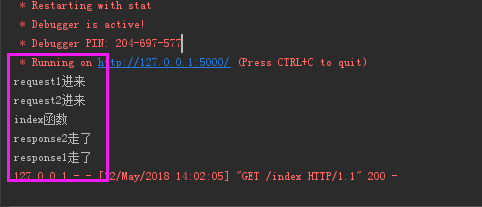1.1.Flask之请求扩展

#!/usr/bin/env python # -*- coding:utf-8 -*- from flask import Flask, Request, render_template app = Flask(__name__, template_folder='templates') app.debug = True @app.before_first_request def before_first_request1(): print('before_first_request1') @app.before_first_request def before_first_request2(): print('before_first_request2') @app.before_request def before_request1(): Request.nnn = 123 print('before_request1') @app.before_request def before_request2(): print('before_request2') @app.after_request def after_request1(response): print('before_request1', response) return response @app.after_request def after_request2(response): print('before_request2', response) return response @app.errorhandler(404) def page_not_found(error): return 'This page does not exist', 404 @app.template_global() def sb(a1, a2): return a1 + a2 @app.template_filter() def db(a1, a2, a3): return a1 + a2 + a3 @app.route('/') def hello_world(): return render_template('hello.html') if __name__ == '__main__': app.run()
(1)基于before_request 做用户登录认证
@app.before_request def process_request(*args,**kwargs): #登录页面不需要验证 if request.path == '/login': return None user = session.get('user_info') if user: return None return redirect('/login')
(2)before_request和after_request执行顺序
from flask import Flask,render_template,request,redirect,session,url_for app = Flask(__name__) app.debug = True app.secret_key = 'abcdef' @app.before_request def process_request1(*args,**kwargs): print('request1进来') @app.before_request def process_request2(*args,**kwargs): print('request2进来') @app.after_request def process_response1(response): print('response1走了') return response @app.after_request def process_response2(response): print('response2走了') return response @app.route('/index',methods=['GET']) def index(): print('index函数') return 'hello' if __name__ == '__main__': app.run()
运行结果:

可以看出:
- before_request是从上往下的执行顺序(先1后2)
- after_response是从下往上的执行顺序(先2后1)
(3)请求拦截后,response所有都执行
在process_request 添加一个return
@app.before_request def process_request1(*args,**kwargs): print('request1进来') return "拦截"
再运行结果如下:

(4)定制错误信息
当访问不存在的url,可以自己定制错误信息页面
@app.errorhandler(404) def error_404(arg): return '404错误'
1.2.数据库连接池
DBUtils是Python的一个用于实现数据库连接池的模块。
安装
进官网下载https://pypi.org/project/DBUtils/1.2/,然后安装:
连接池有两种方式
(1)模式一
为每个线程创建连接,线程即使调用了close方法,也不会关闭,只是把连接重新放到连接池,供自己线程再次使用。当线程终止时,连接自动关闭。

POOL = PersistentDB( creator=pymysql, # 使用链接数据库的模块 maxusage=None, # 一个链接最多被重复使用的次数,None表示无限制 setsession=[], # 开始会话前执行的命令列表。如:["set datestyle to ...", "set time zone ..."] ping=0, # ping MySQL服务端,检查是否服务可用。# 如:0 = None = never, 1 = default = whenever it is requested, 2 = when a cursor is created, 4 = when a query is executed, 7 = always closeable=False, # 如果为False时, conn.close() 实际上被忽略,供下次使用,再线程关闭时,才会自动关闭链接。如果为True时, conn.close()则关闭链接,那么再次调用pool.connection时就会报错,因为已经真的关闭了连接(pool.steady_connection()可以获取一个新的链接) threadlocal=None, # 本线程独享值得对象,用于保存链接对象,如果链接对象被重置 host='127.0.0.1', port=3306, user='root', password='123', database='pooldb', charset='utf8' ) def func(): conn = POOL.connection(shareable=False) cursor = conn.cursor() cursor.execute('select * from tb1') result = cursor.fetchall() cursor.close() conn.close() func()
(2)模式二,推荐使用的方式
创建多个连接,多线程来时,去获取,
import time import pymysql import threading from DBUtils.PooledDB import PooledDB, SharedDBConnection POOL = PooledDB( creator=pymysql, # 使用链接数据库的模块 maxconnections=6, # 连接池允许的最大连接数,0和None表示不限制连接数 mincached=2, # 初始化时,链接池中至少创建的空闲的链接,0表示不创建 maxcached=5, # 链接池中最多闲置的链接,0和None不限制 maxshared=3, # 链接池中最多共享的链接数量,0和None表示全部共享。PS: 无用,因为pymysql和MySQLdb等模块的 threadsafety都为1,所有值无论设置为多少,_maxcached永远为0,所以永远是所有链接都共享。 blocking=True, # 连接池中如果没有可用连接后,是否阻塞等待。True,等待;False,不等待然后报错 maxusage=None, # 一个链接最多被重复使用的次数,None表示无限制 setsession=[], # 开始会话前执行的命令列表。如:["set datestyle to ...", "set time zone ..."] ping=0, # ping MySQL服务端,检查是否服务可用。# 如:0 = None = never, 1 = default = whenever it is requested, 2 = when a cursor is created, 4 = when a query is executed, 7 = always host='127.0.0.1', port=3306, user='root', password='123', database='pooldb', charset='utf8' ) def func(): # 检测当前正在运行连接数的是否小于最大链接数,如果不小于则:等待或报raise TooManyConnections异常 # 否则 # 则优先去初始化时创建的链接中获取链接 SteadyDBConnection。 # 然后将SteadyDBConnection对象封装到PooledDedicatedDBConnection中并返回。 # 如果最开始创建的链接没有链接,则去创建一个SteadyDBConnection对象,再封装到PooledDedicatedDBConnection中并返回。 # 一旦关闭链接后,连接就返回到连接池让后续线程继续使用。 conn = POOL.connection() # print(th, '链接被拿走了', conn1._con) # print(th, '池子里目前有', pool._idle_cache, ' ') cursor = conn.cursor() cursor.execute('select * from tb1') result = cursor.fetchall() conn.close() func()
如果没有连接池,使用pymysql来连接数据库时,单线程应用完全没有问题,但如果涉及到多线程应用那么就需要加锁,一旦加锁那么连接势必就会排队等待,当请求比较多时,性能就会降低了。
import pymysql import threading from threading import RLock LOCK = RLock() CONN = pymysql.connect(host='127.0.0.1', port=3306, user='root', password='123', database='pooldb', charset='utf8') def task(arg): with LOCK: cursor = CONN.cursor() cursor.execute('select * from tb1') result = cursor.fetchall() cursor.close() print(result) for i in range(10): t = threading.Thread(target=task, args=(i,)) t.start()
